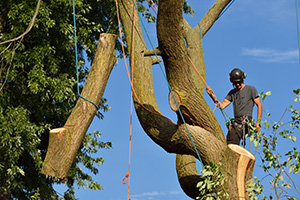
In the town of Smithville, the landscape clearly shows how the community is committed to maintaining its natural beauty. However, there are instances where tree removal in Smithville becomes necessary. However, in these circumstances, it is never the first choice. Most of the time the decision comes down to the safety and well-being of residents and the environment. To avoid premature tree removal, proactive measures are essential. These include regular tree health assessments by certified arborists, proper pruning and care, and disease management. When prevention is possible, there are many strategies tree companies use. Yet, these efforts are sometimes insufficient against the challenges of disease, structural instability, or safety hazards. In such cases, tree removal is approached with a sense of responsibility. Tree experts ensure the health of the community and its natural surroundings are considered as well.
Preservation Strategies of Tree Companies in Smithville
Tree companies typically explore several alternatives before resorting to removing a tree. These methods aim to preserve the tree in its current location. Tree removal is always as a last resort. A few of the most common preservation strategies of tree companies in the area are:
- Pruning or Trimming: This process removing dead, diseased, or overgrown branches to improve the tree’s health and structure. Pruning can sometimes alleviate the issues causing concern, such as branches threatening a structure.
- Cabling and Bracing: For trees with structural issues, cabling and bracing can provide additional support. This method helps stabilize the tree and prevent further damage or falling.
- Pest and Disease Treatment: If a tree is suffering from an infestation or disease, arborists may try to treat it with specific fungicides or insecticides.
- Root Management: Root pruning is often enough to handle any problems with a tree’s roots.
- Soil Improvement: Sometimes, the health of a tree can be improved by enhancing the soil quality around it, including aeration, fertilization.
- Watering Adjustments: Either over-watering or under-watering can stress a tree. Adjusting the watering schedule can sometimes improve a tree’s health.
- Mulching: Proper mulching can help retain soil moisture, regulate temperature, and reduce weed competition, which can benefit tree health.
- Consultation with Experts: Tree companies often consult with arborists or tree health experts to diagnose issues and determine the best course of action.
These methods and others aim to address the specific issues a tree is facing. Regardless if they are related to health, structural integrity, or environmental factors. If these attempts are unsuccessful, or if the tree poses a significant risk to people, structures, or other trees, removal might be the only viable option.
Tree removal is Necessary Sometimes
Tree removal is sometimes unavoidable, particularly in situations where a tree poses a significant risk to people or property. In other cases, it may be the environment that is in danger. Tree removal is often the only answer when the tree’s health is beyond recovery, like in the case of some diseases or pests. Here are some other instances where tree removal is typically necessary:
- Structural Instability: Trees with significant structural issues, such as a severely leaning trunk or major structural damage, may need to be removed if they cannot be safely stabilized.
- Storm Damage: Severe storms can cause irreparable damage to trees, leaving them dangerously unstable or severely damaged.
- Interference with Infrastructure: Trees that are growing too close to buildings, power lines, or underground utilities, and cannot be safely pruned or relocated, may need to be removed.
- Root System Problems: Trees with root systems that are damaging foundations, plumbing, or other underground utilities typically require removal.
- Invasive Species: Invasive tree species that are harmful to the local ecosystem may be removed to protect native plant life and maintain biodiversity.
- Obstruction or Hazard: Tree removal in Smithville is necessary for trees that obstruct vision on roadways, or pose a hazard to pedestrians or traffic.
- Tree Lifespan: Some trees may have reached the natural end of their lifespan and are in a state of decline that poses risks.
Tree Removal in Smithville is a Last Resort
In all the cases we discussed, tree removal is still a measure of last resort. Tree professionals typically consider it only after all other options have been exhausted or deemed impractical. The decision to perform tree removal in Smithville usually involves a careful assessment by qualified professionals, such as Ben Bivins Tree Experts. These specialists ensure that removal is the most appropriate and necessary action. While the goal is always to preserve trees, recognizing when removal is unavoidable is crucial for the safety and sustainability of our environment. Removal is necessary for trees that are dead, diseased beyond recovery, or posing imminent hazards. This decision, often made by experts, is not taken lightly and involves considering all feasible alternatives.

